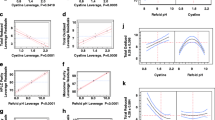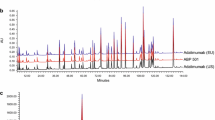Abstract
Purpose
To understand the impact of methionine oxidation in GCSF on efficacy (neutrophil production/activation) and safety (biochemical and histopathological changes).
Methods
Nine GCSF biosimilars were analyzed for the levels of residual iron and copper content. Oxidation in GCSF was induced by H2O2 treatment and four samples were prepared: wtGCSF (no oxidation), MetO (1138), MetO (1,138,127) and MetO (1138,127,122). These samples were used to evaluate binding affinity with the GCSF receptor (GCSFR) using biolayer interferometry, thermal stability using circular dichroism and in vitro potency using a relevant cell-based assay. In vivo pharmacodynamics examined changes in neutrophil production upon GCSF methionine oxidation, with the outcome correlated with the differential expression of genes implicated in the GCSF mediated neutrophil activation/ maturation. Pre-clinical safety studies including biochemical and histopathological changes were also performed.
Results
Met 122 and Met 127 have the most deleterious effect on the potency. Lower binding affinity with GCSFR was identified as the underlying cause for lower efficacy and potency. Role of Asp 110 in GCSF as the critical residue having adverse impact on efficacy in context of methionine oxidation has been elucidated. Impairment of in vitro binding affinity with GCSF manifests as in vivo pharmacodynamic differences via differential expression of downstream genes required for neutrophil maturation.
Conclusion
The data from the present study suggests that methionine oxidation in GCSF is a critical quality attribute that needs careful monitoring and control during commercial manufacturing and subsequent supply chain stages.






Similar content being viewed by others
References
Walsh G. Biopharmaceutical benchmarks 2014. Nat Biotechnol. 2014;32:992–1000. https://doi.org/10.1038/nbt0910-917.
Eon-Duval A, Broly H, Gleixner R. Quality attributes of recombinant therapeutic proteins: an assessment of impact on safety and efficacy as part of a quality by design development approach. Biotechnol Prog. 2012;28:608–22. https://doi.org/10.1002/btpr.1548.
Mohammadian-Mosaabadi J, Naderi-Manesh H, Maghsoudi N, Khalilzadeh R, Shojaosadati SA, Ebrahimi M. Effect of oxidative stress on the production of recombinant human interferon-γ in Escherichia coli. Biotechnol Appl Biochem. 2005;41:37. https://doi.org/10.1042/ba20030230.
Krishnamurthy R, Madurawe RD, Bush KD, Lumpkin JA. Conditions promoting metal-catalyzed oxidations during immobilized cu-Iminodiacetic acid metal affinity chromatography. Biotechnol Prog. 1995;11:643–50. https://doi.org/10.1021/bp00036a007.
Kerwin BA. Polysorbates 20 and 80 used in the formulation of protein biotherapeutics: structure and degradation pathways. J Pharm Sci. 2008;97:2924–35.
Takenawa T, Yokota A, Oda M, Takahashi H, Iwakura M. Protein oxidation during long storage: identification of the oxidation sites in dihydrofolate reductase from Escherichia coli through LC–MS and fragment studies. J Biochem. 2009;145:517–23.
Liu D, Ren D, Huang H, Dankberg J, Rosenfeld R, Cocco MJ, Li L, Brems DN, Remmele RL Jr. Structure and stability changes of human IgG1 Fc as a consequence of methionine oxidation. Biochemistry. 2008;47:5088–100.
Chu J-W, Brooks BR, Trout BL. Oxidation of methionine residues in aqueous solutions: free methionine and methionine in granulocyte colony-stimulating factor. J Am Chem Soc. 2004;126:16601–7.
Chu J-W, Yin J, Wang DIC, Trout BL. Molecular dynamics simulations and oxidation rates of methionine residues of granulocyte colony-stimulating factor at different pH values. Biochemistry. 2004;43:1019–29.
Yin J, Chu J-W, Ricci MS, Brems DN, Wang DIC, Trout BL. Effects of excipients on the hydrogen peroxide-induced oxidation of methionine residues in granulocyte colony-stimulating factor. Pharm Res. 2005;22:141–7.
Chu J, Yin J, Brooks BR, Wang DIC, Ricci MS, Brems DN, Trout BL. A comprehensive picture of non-site specific oxidation of methionine residues by peroxides in protein pharmaceuticals. J Pharm Sci. 2004;93:3096–102.
Wei H, Mo J, Tao L, Russell RJ, Tymiak AA, Chen G, Iacob RE, Engen JR. Hydrogen/deuterium exchange mass spectrometry for probing higher order structure of protein therapeutics: methodology and applications. Drug Discov Today. 2014;19:95–102. https://doi.org/10.1016/j.drudis.2013.07.019.
Torosantucci R, Schöneich C, Jiskoot W. Oxidation of therapeutic proteins and peptides: structural and biological consequences. Pharm Res. 2014;31:541–53.
Steinmann D, Ji JA, Wang YJ, Schöneich C. Oxidation of human growth hormone by oxygen-centered radicals: formation of Leu-101 hydroperoxide and Tyr-103 oxidation products. Mol Pharm. 2012;9:803–14.
Costantino HR, Langer R, Klibanov AM. Moisture-induced aggregation of lyophilized insulin. Pharm Res An Off J Am Assoc Pharm Sci. 1994;11:21–9. https://doi.org/10.1023/A:1018981208076.
Hermeling S, Aranha L, Damen JMA, Slijper M, Schellekens H, Crommelin DJA, Jiskoot W. Structural characterization and immunogenicity in wild-type and immune tolerant mice of degraded recombinant human interferon alpha2b. Pharm Res. 2005;22:1997–2006. https://doi.org/10.1007/s11095-005-8177-9.
van Beers MMC, Sauerborn M, Gilli F, Brinks V, Schellekens H, Jiskoot W. Oxidized and aggregated recombinant human interferon beta is immunogenic in human interferon beta transgenic mice. Pharm Res. 2011;28:2393–402.
Kamberi M, Kim YJ, Jun B, Riley CM. The effects of sucrose on stability of human brain natriuretic peptide [hBNP (1-32)] and human parathyroid hormone [hPTH (1-34)]. J Pept Res. 2008;66:348–56. https://doi.org/10.1111/j.1399-3011.2005.00290.x.
Torosantucci R, Kukrer B, Mero A, Van Winsen M, Tantipolphan R, Jiskoot W. Plain and mono-pegylated recombinant human insulin exhibit similar stress-induced aggregation profiles. J Pharm Sci. 2011;100:2574–85. https://doi.org/10.1002/jps.22523.
Bertolotti-Ciarlet A, Wang W, Lownes R, Pristatsky P, Fang Y, McKelvey T, Li Y, Li Y, Drummond J, Prueksaritanont T, Vlasak J. Impact of methionine oxidation on the binding of human IgG1 to FcRn and Fcγ receptors. Mol Immunol. 2009;46:1878–82. https://doi.org/10.1016/j.molimm.2009.02.002.
Wang S, Ionescu R, Peekhaus N, Leung JY, Ha S, Vlasak J. Separation of post-translational modifications in monoclonal antibodies by exploiting subtle conformational changes under mildly acidic conditions. J Chromatogr A. 2010;1217:6496–502. https://doi.org/10.1016/j.chroma.2010.08.044.
Wei Z, Feng J, Lin HY, Mullapudi S, Bishop E, Tous GI, Casas-Finet J, Hakki F, Strouse R, Schenerman MA. Identification of a single tryptophan residue as critical for binding activity in a humanized monoclonal antibody against respiratory syncytial virus. Anal Chem. 2007;79:2797–805. https://doi.org/10.1021/ac062311j.
Kronenberg S, Baumann A, de Haan L, Hinton HJ, Moggs J, Theil F-P, Wakefield I, Singer T. Current challenges and opportunities in nonclinical safety testing of biologics. Drug Discov Today. 2013;18:1138–43. https://doi.org/10.1016/j.drudis.2013.08.003.
Bendall LJ, Bradstock KF. G-CSF: from granulopoietic stimulant to bone marrow stem cell mobilizing agent. Cytokine Growth Factor Rev. 2014;25:355–67. https://doi.org/10.1016/j.cytogfr.2014.07.011.
Singh SK, Kumar D, Rathore AS. Determination of critical quality attributes for a biotherapeutic in the QbD paradigm: GCSF as a case study. AAPS J. 2017;19:1–16.
Lu HS, Fausset PR, Narhi LO, Horan T, Shinagawa K, Shimamoto G, Boone TC. Chemical modification and site-directed mutagenesis of methionine residues in recombinant human granulocyte colony-stimulating factor: effect on stability and biological activity. Arch Biochem Biophys. 1999;362:1–11.
Bade PD, Kotu SP, Rathore AS. Optimization of a refolding step for a therapeutic fusion protein in the quality by design (QbD) paradigm. J Sep Sci. 2012;35:3160–9. https://doi.org/10.1002/jssc.201200476.
Rathore AS, Bade P, Joshi V, Pathak M, Pattanayek SK. Refolding of biotech therapeutic proteins expressed in bacteria: review. J Chem Technol Biotechnol. 2013;88:1794–806. https://doi.org/10.1002/jctb.4152.
Bhambure R, Gupta D, Rathore AS. A novel multimodal chromatography based single step purification process for efficient manufacturing of an E. coli based biotherapeutic protein product. J Chromatogr A. 2013;1314:188–98.
Nupur N, Singh SK, Narula G, Rathore AS. Assessing analytical comparability of biosimilars: GCSF as a case study. J Chromatogr B. 2016;1032:165–71. https://doi.org/10.1016/j.jchromb.2016.05.027.
Marchi LF, Sesti-Costa R, Chedraoui-Silva S, Mantovani B. Comparison of four methods for the isolation of murine blood neutrophils with respect to the release of reactive oxygen and nitrogen species and the expression of immunological receptors. Comp Clin Path. 2014;23:1469–76.
Kumar D, Das B, Sen R, Kundu P, Manna A, Sarkar A, Chowdhury C, Chatterjee M, Das P. Andrographolide analogue induces apoptosis and autophagy mediated cell death in U937 cells by inhibition of PI3K/Akt/mTOR pathway. PLoS One. 2015;10:e0139657.
Livak KJ, Schmittgen TD. Analysis of relative gene expression data using real-time quantitative PCR and the 2− ΔΔCT method. Methods. 2001;25:402–8.
Martos A, Koch W, Jiskoot W, Wuchner K, Winter G, Friess W, et al. Trends on analytical characterization of polysorbates and their degradation products in biopharmaceutical formulations. J Pharm Sci. 2017;106(7):1722–35.
Kranz W, Wuchner K, Corradini E, Menzen T, Hawe A. Micelle driven oxidation mechansim and novel oxidation markers for different grades of polysorbate 20 and 80. J Pharm Sci. 2020; In press
Grabarek AD, Bozic U, Rousel J, Menzen T, Kranz W, Wuchner K, Jiskoot W, Hawe A. What makes polysorbate functional? Impact of polysorbate 80 grade and quality on igg stability during mechanical stress. J Pharm Sci. 2020;109(1):871–80.
Rathore AS, Kumar D, Kateja N. Role of raw materials in biopharmaceutical manufacturing: risk analysis and fingerprinting. Curr Opin Biotechnol. 2018;53:99–105.
Greenfield NJ. Using circular dichroism spectra to estimate protein secondary structure. Nat Protoc. 2006;1:2876–90.
Kolvenbach CG, Narhi LO, Philo JS, Li T, Zhang M, Arakawa T. Granulocyte-colony stimulating factor maintains a thermally stable, compact, partially folded structure at pH 2. Chem Biol Drug Des. 1997;50:310–8.
Avalos BR. Molecular analysis of the granulocyte colony-stimulating factor receptor. Blood-New York. 1996;88:761–77.
Gabrielsson J, Weiner D. Non-compartmental analysis. In Computational toxicology (Springer), 377–389.
Pedersen CC, Borup R, Fischer-Nielsen A, Mora-Jensen H, Fossum A, Cowland JB, Borregaard N. Changes in gene expression during G-CSF–induced emergency granulopoiesis in humans. J Immunol. 2016;197:1989–99. https://doi.org/10.4049/jimmunol.1502690.
Wang J, Arase H. Regulation of immune responses by neutrophils. Ann N Y Acad Sci. 2014;1319:66–81. https://doi.org/10.1111/nyas.12445.
Hirai H, Zhang P, Dayaram T, Hetherington CJ, Mizuno SI, Imanishi J, Akashi K, Tenen DG. C/EBPβ is required for “emergency” granulopoiesis. Nat Immunol. 2006;7:732–9. https://doi.org/10.1038/ni1354.
Bjerregaard MD, Jurlander J, Klausen P, Borregaard N, Cowland JB. The in vivo profile of transcription factors during neutrophil differentiation in human bone marrow. Blood. 2003;101:4322–32. https://doi.org/10.1182/blood-2002-03-0835.
Kolvenbach CG, Elliott S, Sachdev R, Arakawa T, Narhi LO. Characterization of two fluorescent tryptophans in recombinant human granulocyte-colony stimulating factor: comparison of native sequence protein and tryptophan-deficient mutants. J Protein Chem. 1993;12:229–36.
Acknowledgements
This work was funded by the Center of Excellence for Biopharmaceutical Technology grant from Department of Biotechnology, Government of India (number BT/COE/34/SP15097/2015).
Author information
Authors and Affiliations
Corresponding author
Ethics declarations
Conflict of Interest
The authors declare no competing interests.
Bioethics Statement
The animal study was reviewed and approved by Institutional Animal Ethics Committee (IAEC), Central Laboratory Animal Resources, Jawaharlal Nehru University, Registration No. 19/GO/ReBi/99/CPCSEA, (IAEC Code: 13/2016). Efforts were made to keep the number of animals at the minimum and cause no pain beyond what is associated with routine injection and blood withdrawal.
Additional information
Guest Editors: Ahmed Besheer and Hanns-Christian Mahler
Publisher’s Note
Springer Nature remains neutral with regard to jurisdictional claims in published maps and institutional affiliations.
Electronic supplementary material
ESM 1
(DOCX 65 kb)
Rights and permissions
About this article
Cite this article
Singh, S.K., Kumar, D. & Rathore, A.S. Understanding Oxidation Propensity in GCSF and Assessment of its Safety and Efficacy. Pharm Res 37, 207 (2020). https://doi.org/10.1007/s11095-020-02928-3
Received:
Accepted:
Published:
DOI: https://doi.org/10.1007/s11095-020-02928-3




